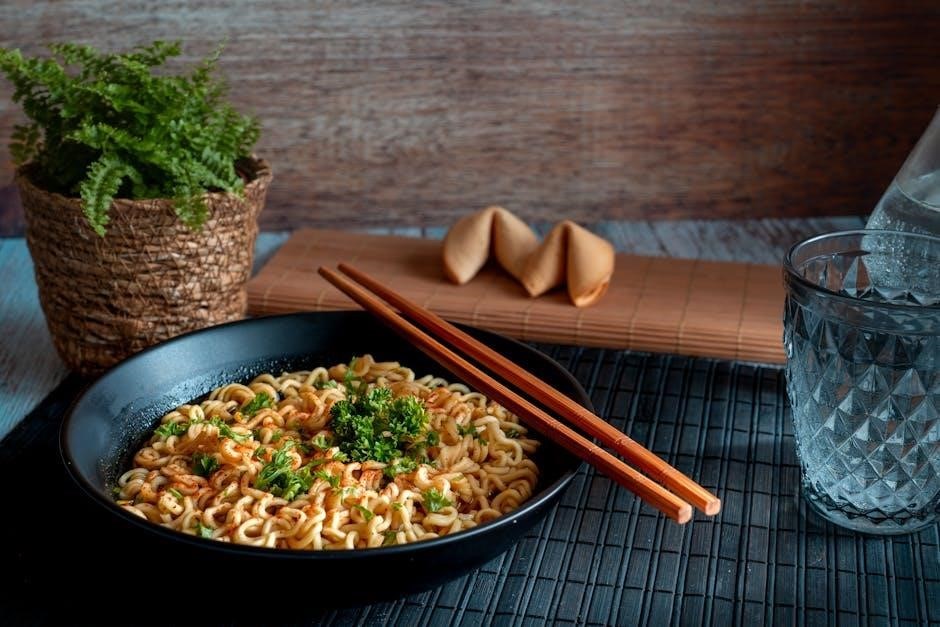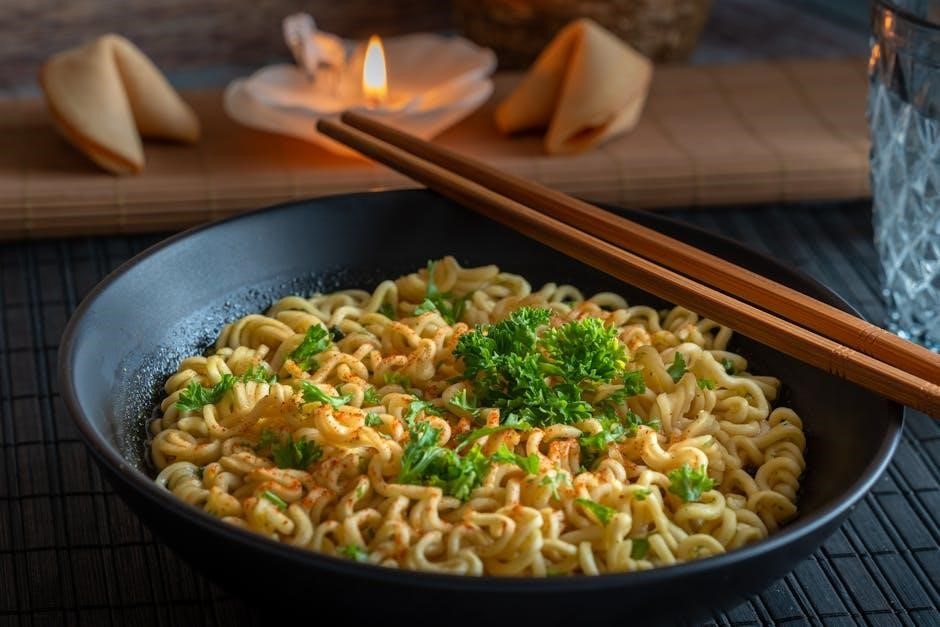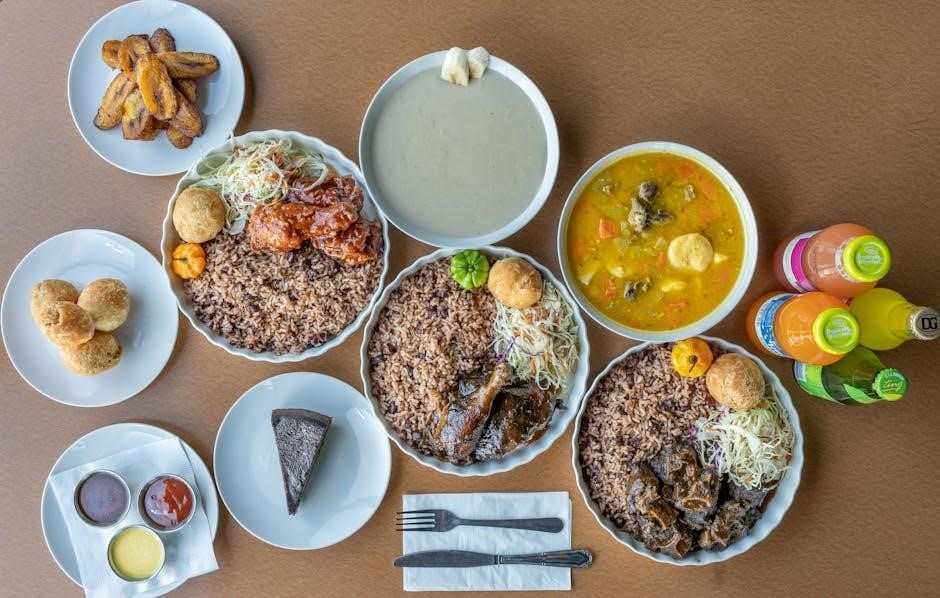chicken soup pdf
Chicken soup is a beloved dish worldwide, offering comfort and warmth. Its versatility allows for countless variations, from classic noodle soups to spicy and vegetarian options, making it a universal favorite.
1.1 Historical Background of Chicken Soup
Chicken soup has ancient roots, with evidence of its existence dating back to early civilizations. It was first mentioned in Chinese medical texts around 2,000 BCE as a remedy for colds. The dish later spread globally, adapting to local tastes. Jewish tradition popularized it as a comfort food in the 12th century. Its simplicity and nourishing qualities made it a staple across cultures, with each region adding unique ingredients. This versatile dish has evolved over centuries, remaining a symbol of care and healing in many societies, highlighting its enduring appeal and universal connection to home and well-being.
1.2 Cultural Significance of Chicken Soup
Chicken soup holds profound cultural significance, often symbolizing comfort and care. In Jewish tradition, it’s a staple at family gatherings and a remedy for ailments; Across Asia, it’s served at special occasions, while in Italy, it’s a hearty, nourishing dish. The soup’s versatility allows it to adapt to diverse cuisines, making it a universal comfort food. Its presence in literature, media, and home kitchens underscores its role in bringing people together. Chicken soup is more than a meal; it’s a symbol of love, healing, and tradition, transcending borders and uniting cultures through its simple, nourishing appeal.
1.3 Why Chicken Soup is a Popular Choice
Chicken soup’s popularity stems from its simplicity, accessibility, and universal appeal. It’s a versatile dish that can be tailored to any taste, making it a favorite worldwide. The combination of tender chicken, fresh vegetables, and aromatic spices creates a hearty, comforting meal. Additionally, its nutritional benefits, including high protein and low calories, make it a healthy option. Many cultures have their own versions, from spicy Tom Yum in Thailand to Italian chicken noodle soups. Its ease of preparation and the ability to use leftover ingredients further enhance its appeal. Whether homemade or store-bought, chicken soup remains a go-to choice for comfort and nourishment.
Ingredients for Chicken Soup
Chicken soup typically includes chicken, vegetables like carrots, celery, onions, garlic, spinach, and barley, along with herbs and spices such as bay leaves, coriander, and thyme.
2.1 Essential Proteins: Chicken and Alternatives
Chicken is the star protein in most soups, typically using boneless, skinless chicken breasts or thighs. Ground chicken is also an option for a heartier texture. Vegetarian alternatives include tofu, tempeh, or edamame, offering plant-based protein sources that blend seamlessly into the broth. These substitutes maintain the soup’s nutritional value while catering to diverse dietary preferences. The choice of protein can significantly impact the flavor profile, with chicken providing a traditional taste and alternatives offering a modern twist. This versatility ensures that chicken soup remains adaptable to various lifestyles and tastes, making it a universally appealing dish.
2.2 Vegetables Commonly Used
Vegetables are essential in chicken soup, adding flavor, texture, and nutrients. Carrots, celery, and onions are staples, providing a classic aromatic base. Garlic is often included for its depth of flavor. Mushrooms, spinach, and kale are popular additions, enhancing the soup’s nutritional value. Potatoes and zucchini can add heartiness, while bell peppers introduce a pop of color. Vegetables are typically sautéed initially to bring out their flavors before simmering in the broth. Their versatility allows for customization, ensuring the soup suits various tastes and dietary needs. Whether traditional or inventive, vegetables play a vital role in making chicken soup a wholesome and satisfying meal.
2.3 Herbs and Spices for Flavor

Herbs and spices are key to enhancing the flavor of chicken soup. Common additions include garlic, coriander, celery seeds, and bay leaves, which add aromatic depth. Rosemary and thyme are popular for their earthy notes, while black pepper provides a subtle kick. Lemon peel or juice can add brightness, balancing the richness. In some recipes, cumin and turmeric are used for a warm, earthy flavor, especially in Middle Eastern-inspired soups. These ingredients are typically sautéed with vegetables or added during simmering to infuse the broth. The combination of herbs and spices creates a harmonious flavor profile, making the soup both comforting and delicious.

Cooking Methods for Chicken Soup
Chicken soup can be cooked using various methods, including stovetop, slow cooker, or oven. Each method offers unique advantages, ensuring a delicious and hearty meal every time.
3.1 Traditional Stovetop Method
The traditional stovetop method involves sautéing chicken, vegetables, and aromatics in olive oil, then simmering in broth until tender. This approach allows for easy monitoring and flavor adjustment, making it a timeless favorite for home cooks. The process typically starts with browning the chicken to enhance flavor, followed by adding vegetables like carrots, celery, and onions. Bay leaves, garlic, and herbs are common additions for depth. Simmering on low heat ensures the chicken is tender and the soup is rich. This method is versatile, accommodating various ingredients and seasonings to suit personal preferences, while maintaining the comforting essence of homemade chicken soup.
3.2 Slow Cooker Chicken Soup
The slow cooker method offers a convenient way to prepare chicken soup with minimal effort. Simply brown the chicken and sauté aromatics like garlic, onions, and carrots in a pan, then transfer everything to the slow cooker with broth and herbs. Cooking on low for 6-8 hours ensures tender chicken and a rich, flavorful broth. This hands-off approach is ideal for busy days, allowing the soup to simmer while you attend to other tasks. Some recipes suggest adding noodles or rice toward the end of cooking for a hearty meal. The slow cooker method retains nutrients and enhances flavors, making it a popular choice for home cooks seeking comfort and convenience.

3.3 Vegetarian and Vegan Variations

Vegetarian and vegan versions of chicken soup offer delicious and compassionate alternatives. Plant-based proteins like tofu, tempeh, or chickpeas replace chicken, while vegetables such as carrots, celery, and spinach add freshness. Herbs and spices like garlic, ginger, and turmeric enhance flavor without meat. Vegan broth substitutes chicken stock, ensuring a cruelty-free base. Lentils or mushrooms can provide hearty texture, making the soup satisfying. These variations cater to dietary preferences while retaining the comforting essence of traditional chicken soup. They are ideal for those seeking a meat-free, nutritious, and flavorful meal option that aligns with ethical and environmental values. This adaptation proves that soup can be both kind and delicious.
Health Benefits of Chicken Soup
Chicken soup is renowned for its healing properties, aiding in cold relief and providing essential nutrients. It reduces inflammation, soothes congestion, and offers comfort during recovery, making it a natural remedy for wellness.
4.1 Chicken Soup and Cold Relief
Chicken soup has long been a natural remedy for cold relief, offering comfort and easing symptoms. The steam from hot soup helps clear nasal congestion, while its anti-inflammatory properties soothe sore throats. Rich in vitamins and antioxidants from vegetables, it boosts the immune system, helping to fight off infections. The combination of chicken, vegetables, and herbs creates a nourishing broth that replenishes fluids and provides essential nutrients. Many recipes include garlic, known for its antimicrobial benefits, further enhancing the soup’s healing effects. This timeless dish is not only a comforting meal but also a practical solution for alleviating cold symptoms, making it a staple in households worldwide during flu season.
4.2 Nutritional Value of Chicken Soup
Chicken soup is a nutrient-rich dish, providing essential vitamins, minerals, and proteins. The chicken serves as an excellent source of lean protein, vital for muscle repair and immune function. Vegetables such as carrots, celery, and onions add fiber, vitamins A and C, and antioxidants. Herbs and spices enhance flavor while contributing anti-inflammatory compounds. The broth is rich in electrolytes, helping to replenish fluids and support hydration. This combination makes chicken soup a balanced meal, particularly beneficial for those seeking comfort and nourishment during recovery. Its wholesome ingredients ensure a boost of energy and overall well-being, making it a nutritious choice for various dietary needs.
4.3 Anti-Inflammatory Properties
Chicken soup exhibits anti-inflammatory properties due to its ingredients. Spices like turmeric, ginger, and black pepper contain compounds that reduce inflammation. Vegetables such as carrots, celery, and onions provide antioxidants that combat oxidative stress. The steam from hot soup helps clear nasal passages, alleviating sinus congestion. Chicken itself contains cysteine, an amino acid that thins mucus, further aiding respiratory health. Additionally, the broth’s electrolytes and hydration properties support the body’s natural healing processes. These elements combined make chicken soup a soothing, anti-inflammatory remedy, particularly effective for colds and flu. Its natural benefits have made it a trusted home remedy for centuries, offering both comfort and healing;

Cultural Variations of Chicken Soup
Chicken soup varies globally, reflecting local tastes and traditions. Italian versions use noodles, while Thai recipes incorporate coconut milk and lemongrass, showcasing diverse culinary influences.

5.1 Chicken Soup in Different Cuisines
Chicken soup is a universal dish, adapted across cultures. Italian versions often feature homemade noodles, while Thai recipes incorporate coconut milk and lemongrass for a spicy twist. In India, dal, a lentil-based chicken soup, is popular. Jewish cuisine offers matzo ball soup, with dumplings made from matzo meal. Mexican dishes like caldo de pollo blend chicken with vibrant vegetables and aromatic spices. Each culture infuses its flavors, creating unique variations that reflect local traditions and ingredients, making chicken soup a true global culinary staple.
5.2 Regional Twists and Specialties
Regional twists add unique flavors to chicken soup. In the southern United States, cream-based soups with corn and potatoes are common. Eastern Europe features hearty soups with barley and root vegetables. Asian-inspired broths often include ginger, soy sauce, and sesame oil for depth. Mexican variations, like pozole, incorporate hominy and chili peppers. Mediterranean recipes add feta, olives, and sun-dried tomatoes. Each region’s ingredients and spices create distinctive, flavorful profiles, making chicken soup a dish that reflects local tastes and traditions while maintaining its comforting essence.

5.3 Chicken Soup in Media and Literature
Chicken soup has become a cultural icon in media and literature, symbolizing comfort and healing. It is often featured in films, books, and advertisements as a remedy for the soul. In literature, chicken soup is frequently used as a metaphor for home, family, and recovery. The famous book Chicken Soup for the Soul highlights its emotional significance. In media, it appears in cooking shows, comics, and even memes, showcasing its universal appeal. This dish transcends cuisine, becoming a symbol of care and nostalgia, deeply rooted in global popular culture and storytelling.
Chicken Soup Recipes
Chicken soup offers diverse recipes, from classic chicken noodle to spicy and vegetarian variations. These dishes cater to various tastes, emphasizing customization with herbs and spices.
6.1 Classic Chicken Noodle Soup
Classic chicken noodle soup is a timeless comfort dish, blending tender chicken, soft noodles, and aromatic vegetables in a flavorful broth. Begin by browning chicken breasts or thighs in olive oil, then add diced carrots, celery, and garlic. Pour in chicken broth, bring to a boil, and simmer until the chicken is cooked through. Stir in noodles like egg noodles or rice noodles and cook until tender. Season with salt, pepper, and herbs like parsley or thyme. Serve hot, garnished with fresh herbs or a sprinkle of black pepper. This simple, hearty soup is a go-to for cozy meals and soothing colds, loved by all ages.
6.2 Grandma’s Chicken Soup Recipe
Grandma’s chicken soup is a heartwarming, traditional recipe passed down through generations. It begins with simmering chicken, carrots, celery, and onions in a rich broth, seasoned with garlic, bay leaves, and a touch of schmaltz for authenticity. Noodles or matzo balls are added for texture, creating a hearty, comforting dish. The slow-cooked broth develops a deep, savory flavor, while fresh parsley adds a bright finish. This recipe is a testament to home-cooked love, perfect for chilly days or soothing a cold. Serve with a side of crusty bread for a nostalgic meal that feels like a warm hug from home.
6.3 Chicken and Rice Soup
Chicken and rice soup is a comforting and flavorful dish, perfect for a cozy meal. It combines tender chicken, aromatic spices, and soft, fluffy rice in a light, savory broth. The recipe often includes vegetables like carrots, onions, and garlic for added depth. Lemon juice or zest can be added for a bright, citrusy note. The chicken is typically simmered with herbs like bay leaves and thyme, while the rice absorbs the rich flavors of the broth. This soup is simple yet satisfying, served hot with a sprinkle of fresh parsley or a side of crusty bread for a hearty, warming meal.
6.4 Spicy Chicken Soup Variations
Spicy chicken soup variations add a bold kick to the classic dish, offering a vibrant twist for those who enjoy heat. Inspired by global cuisines, these soups often incorporate chili peppers, cayenne, or spicy sauces. Thai Tom Yum soup, for instance, blends chicken with lemongrass, lime leaves, and chili for a zesty, aromatic flavor. Mexican-inspired soups might include jalapeños, cumin, and tortillas for a hearty, fiery broth. Spices like cayenne pepper or red chili flakes can elevate traditional recipes, while ingredients like ginger and garlic add depth. These variations not only tantalize the taste buds but also provide a refreshing contrast to milder versions, making them perfect for adventurous eaters seeking a flavorful and invigorating meal.

Serving Suggestions

Chicken soup pairs well with crusty bread, crackers, or a side salad. Garnish with fresh herbs or a squeeze of lemon for added freshness and flavor.
7.1 Side Dishes to Pair with Chicken Soup
Chicken soup can be elevated by serving it with crusty bread or crackers for dipping. A fresh green salad adds a refreshing contrast, while roasted vegetables provide a satisfying crunch. Rice or egg noodles are great for sopping up the broth. For a hearty meal, try pairing it with garlic knots or breadsticks. These options complement the flavors and textures of the soup, making it a well-rounded and enjoyable dish.
7.2 Garnishes and Toppings
Garnishes and toppings can elevate chicken soup to new heights. Fresh herbs like parsley, cilantro, or dill add a bright, fresh flavor. A squeeze of lemon or lime juice provides a citrusy zing. For added texture, consider crushed nuts, crispy fried onions, or toasted seeds. Avocado slices or a dollop of sour cream introduce creaminess. Crispy tortilla strips or croutons add a satisfying crunch. Grated cheese, like cheddar or Parmesan, enhances richness. These toppings allow customization, making each bowl unique and flavorful. They also add visual appeal, turning a simple soup into a visually enticing meal.
7.3 Chicken Soup as a Meal
Chicken soup can easily stand as a complete meal due to its balanced mix of protein, vegetables, and carbohydrates. Pairing it with crusty bread or a side salad enhances its satisfying nature. For heartier options, adding rice, quinoa, or pasta increases its filling potential. Customizing with toppings like avocado or cheese boosts both flavor and nutrition. This versatility makes it a perfect option for family dinners or individual meals. Its comforting warmth and wholesome ingredients ensure it remains a timeless choice for any occasion, providing sustenance and comfort in every bowl.
Chicken soup remains a timeless, universal dish, cherished for its comforting warmth and versatility, making it a beloved choice across cultures and generations alike.
8.1 Final Thoughts on Chicken Soup
Chicken soup embodies universal comfort, transcending cultures with its warm, soothing essence. Its versatility allows for endless variations, catering to diverse tastes and dietary needs. Whether homemade or store-bought, it remains a cherished remedy for both body and soul. The simplicity of its ingredients combined with the depth of its flavors makes it a timeless dish. Chicken soup is more than just a meal; it’s a symbol of care, tradition, and shared moments. Its ability to evoke nostalgia and provide solace ensures its enduring popularity. As a blank canvas for creativity, chicken soup continues to inspire new recipes while remaining a beloved classic.
8.2 Encouragement to Try New Recipes
Exploring new chicken soup recipes can be a delightful adventure, offering fresh flavors and exciting twists. From spicy additions like chili flakes to aromatic herbs or international inspirations, there’s endless potential to reinvent this classic dish. Don’t hesitate to experiment with ingredients or cooking methods—whether it’s adding unique vegetables, trying vegetarian or vegan versions, or incorporating global spices. Each variation brings a new dimension to this timeless favorite. Embrace the creativity and fun of cooking by trying something different. With so many possibilities, you might just discover a new family favorite, making chicken soup a dish that continues to evolve and delight.
8.3 The Timeless Appeal of Chicken Soup
Chicken soup’s enduring popularity stems from its universal comfort and adaptability. Across cultures and generations, it remains a staple, offering solace in its warm, hearty flavors. Its simplicity allows for personalization, making it accessible to everyone. Whether enjoyed during illness or as a cozy meal, chicken soup’s appeal lies in its ability to evoke nostalgia and provide comfort. Its versatility ensures it stays relevant, with countless recipes catering to diverse tastes. This beloved dish continues to be a symbol of care and nourishment, transcending time and trends, making it a timeless favorite in kitchens worldwide. Its charm is in its simplicity and the love it carries.